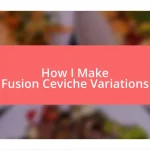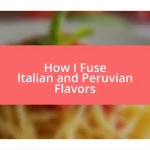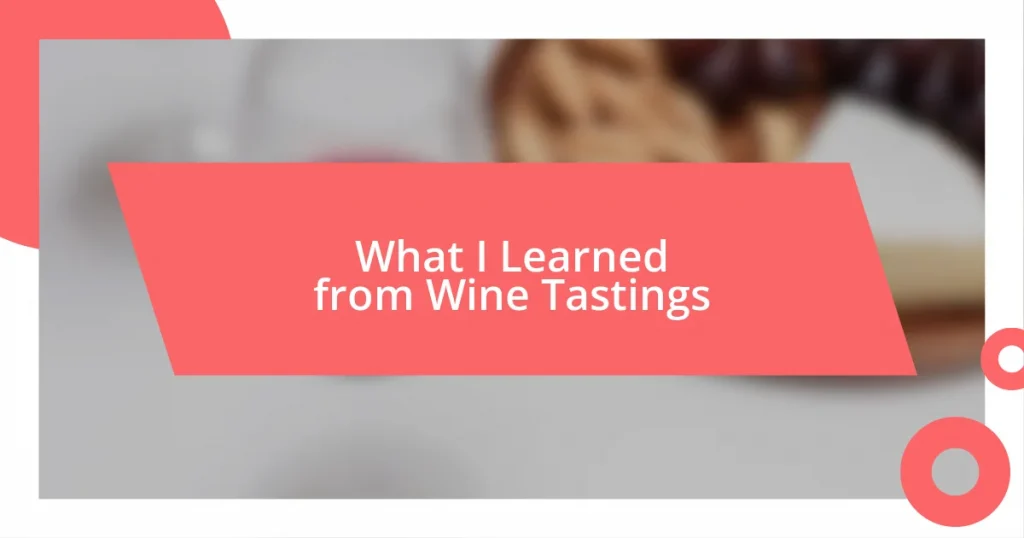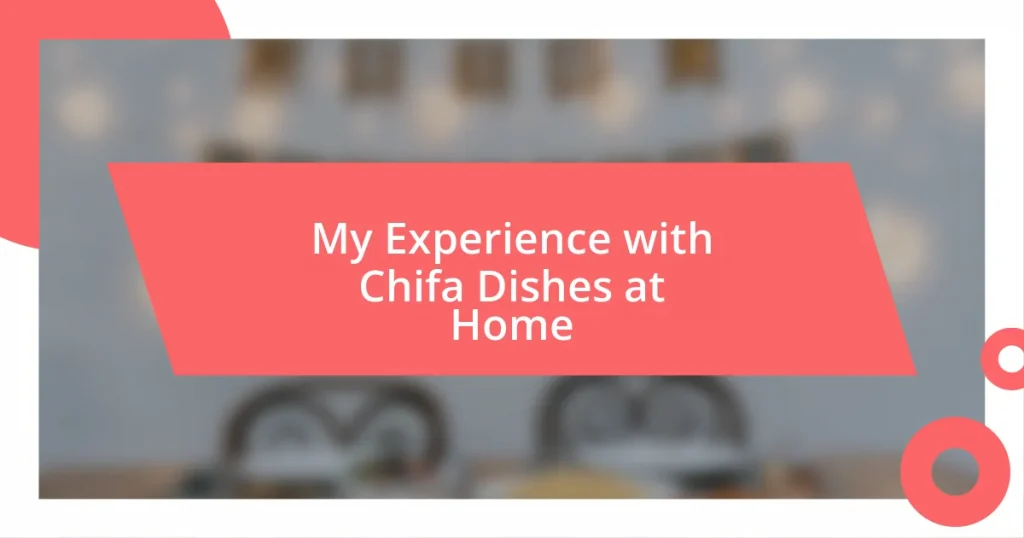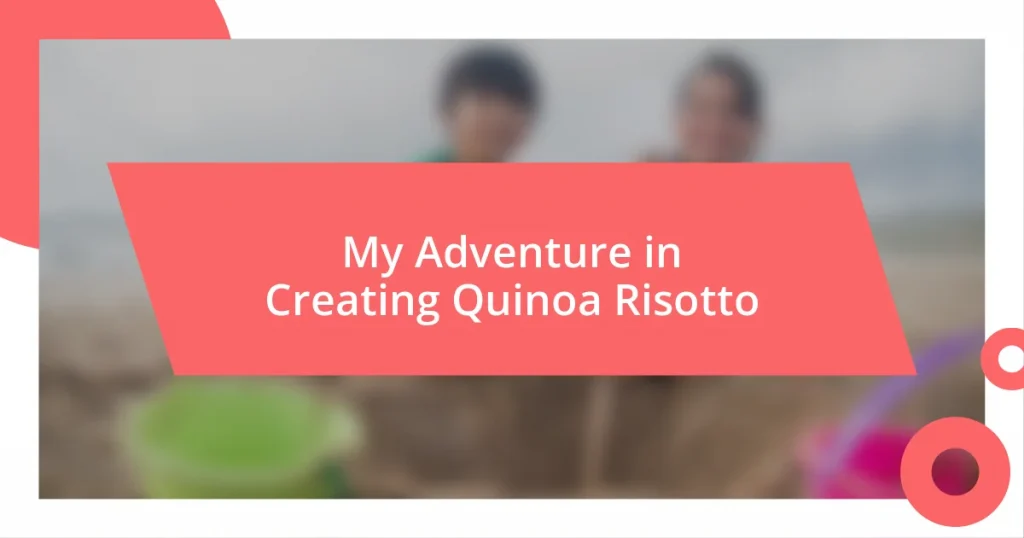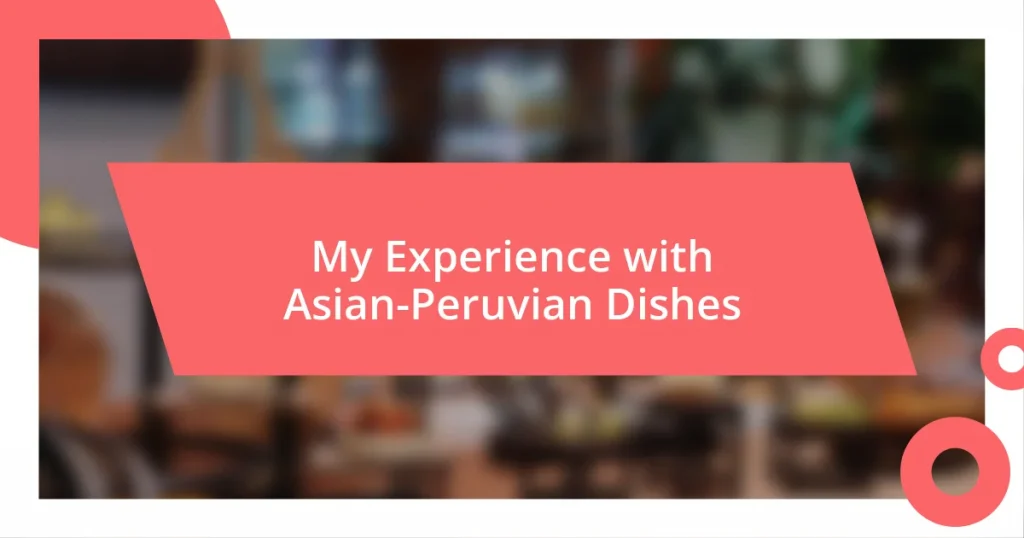Key takeaways:
- Understanding wine involves recognizing the significance of aromas, which can enhance the tasting experience and reveal complex characteristics of the wine.
- Mastering tasting techniques, such as swirling and savoring flavors in stages, deepens the appreciation for wine and fosters engaging discussions with fellow tasters.
- Food pairing is essential; matching wine with meals based on flavor profiles can elevate both the food and wine experience, revealing cultural connections and enhancing enjoyment.
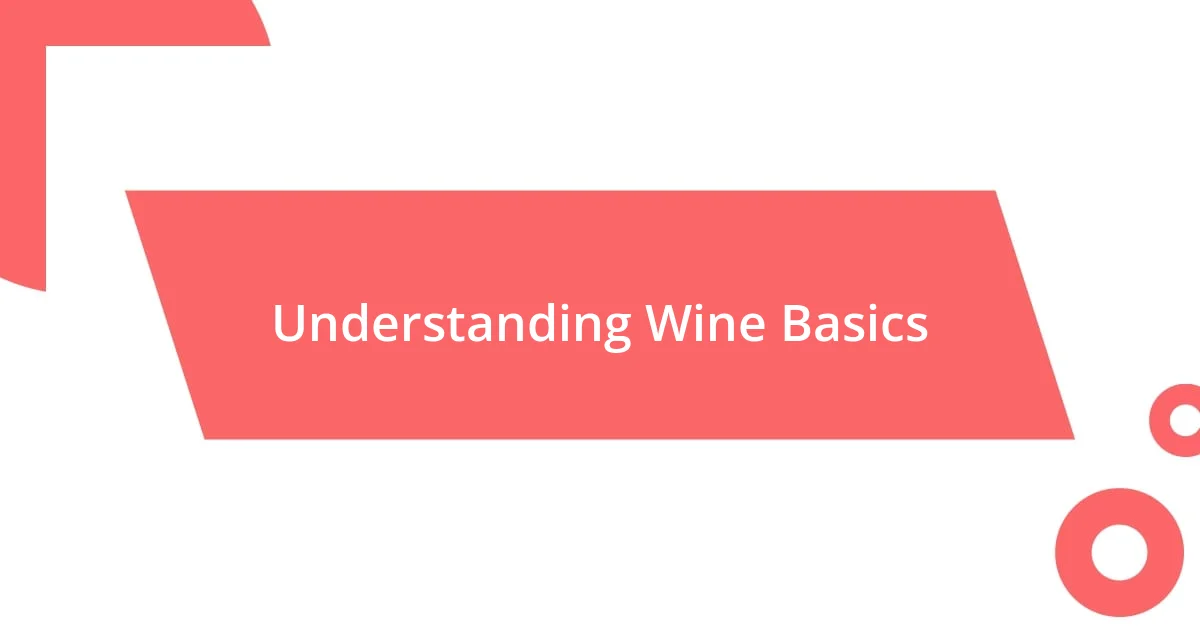
Understanding Wine Basics
When I first dove into the world of wine, I found myself overwhelmed by the sheer variety of choices. Did you know there are over 10,000 grape varieties used globally? Each one brings a unique flavor profile, aroma, and body to the wine. This diversity is what often makes each tasting feel like a new adventure—one that I never want to end.
Understanding key terms is essential in this journey. For instance, when someone mentions “tannins,” I remember my initial reaction: confusion. Tannins are the compounds that give red wines their astringent taste, and they come from grape skins, seeds, and stems. The moment I could connect that term to something tangible, I felt more confident when expressing my own preferences.
As I explored different regions and styles, I discovered that wine is more than just a drink—it’s a reflection of culture and artistry. Have you ever noticed how a glass of wine can transport you to a different place? For me, sipping a bold Malbec from Argentina evokes memories of warm evenings and laughter with friends. This emotional connection is what makes wine tasting such a rich experience, blending flavors with memories and sensations.
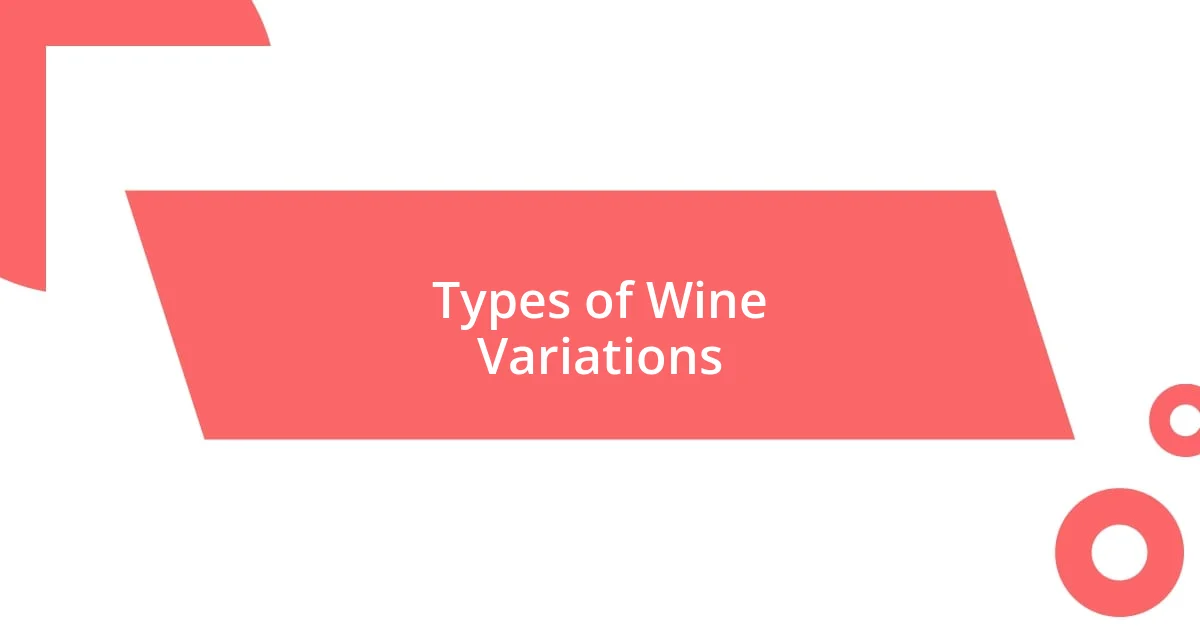
Types of Wine Variations
Wine variations can be categorized into several types, primarily based on their grape variety, fermentation process, and region of origin. For example, the distinction between red and white wine is not just in color; it reflects the use of different grapes and fermentation techniques. When I attended a tasting featuring a crisp Sauvignon Blanc alongside a robust Cabernet Sauvignon, the contrast was striking. I realized then how each wine can narrate a different story based on its origin and what makes it unique.
Another fascinating aspect is the variations within the same type of wine, such as a Merlot from one region versus another. I recall tasting a Merlot from California that burst with fruity notes, while one from Bordeaux had a more earthy character. These subtleties are what make each sip an exciting learning experience. Not only does it reveal the grape’s potential, but it also speaks volumes about the terroir—the environment where the grapes are grown, including soil, climate, and culture. Have you ever experienced a wine that surprised you with its depth and complexity? Those moments are truly memorable.
Lastly, sparkling wines, such as Champagne or Prosecco, offer yet another layer of enjoyment. The moment those bubbles danced in my glass, I felt a sense of celebration and joy wash over me. It’s incredible how variations in production methods, like the traditional method versus the tank method, can create vastly different experiences in the same category. Wine tasting invites us to explore these variations intimately, allowing each different kind to spark joy and curiosity within us.
| Type of Wine | Characteristics |
|---|---|
| Red | Full-bodied, rich flavors, often tannic |
| White | Crisp, refreshing, can be fruity or floral |
| Sparkling | Bubbles, often vibrant and celebratory |
| Rosé | Light, fruity, a mix of red and white wine qualities |
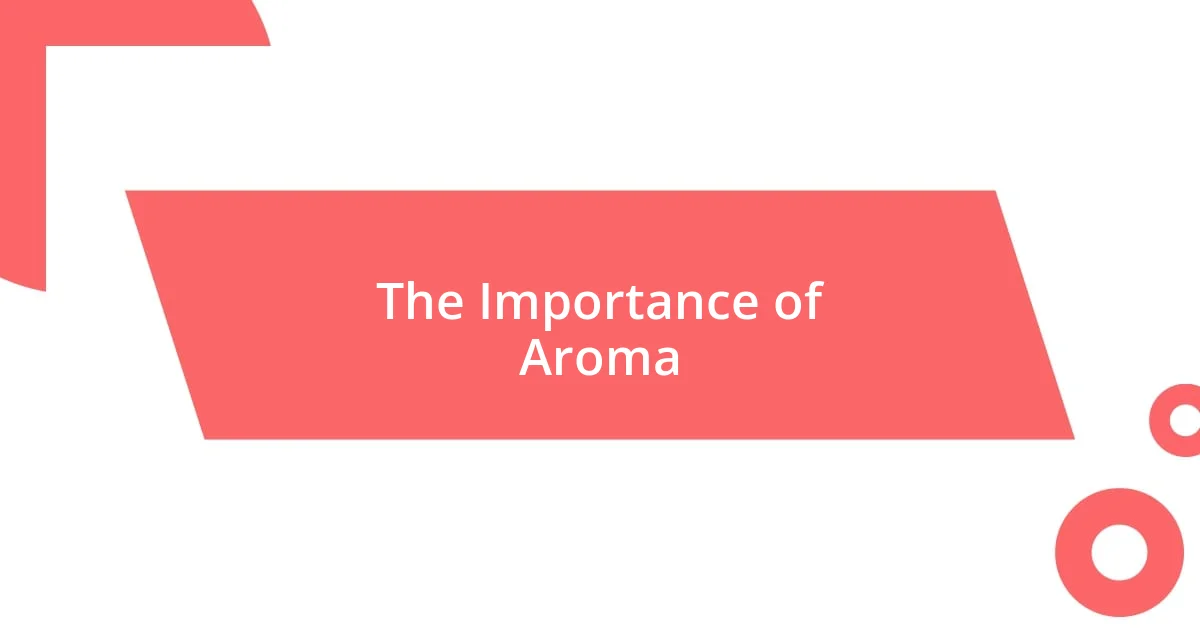
The Importance of Aroma
I can’t emphasize enough how crucial aroma is in wine tasting. Each whiff of a wine can unveil a tapestry of scents—from fruity and floral to earthy and spicy. I remember my first wine tasting, where I encountered an aromatic Viognier that enveloped me in scents of peach and jasmine. It struck me that, like a favorite song, aromas can evoke strong memories. Just inhaling that wine transported me to carefree summer afternoons spent outdoors.
When I learned to pay attention to aromas, the experience shifted dramatically. Instead of simply tasting, I began to enjoy a multi-sensory journey. Here are some key insights on the importance of aroma:
- Aromas Influence Flavor: The nose and palate work in tandem; much of what we “taste” is actually what we smell.
- Identifying Wine Characteristics: Aroma can indicate grape variety and the wine’s age, region, and even the fermentation process.
- Enhancing Enjoyment: A wine’s aroma can heighten the overall experience, turning a simple sip into an adventure.
The more I explored, the more I realized how directly aromas could lead to unexpected stories, making each tasting a rich narrative filled with both taste and memory.
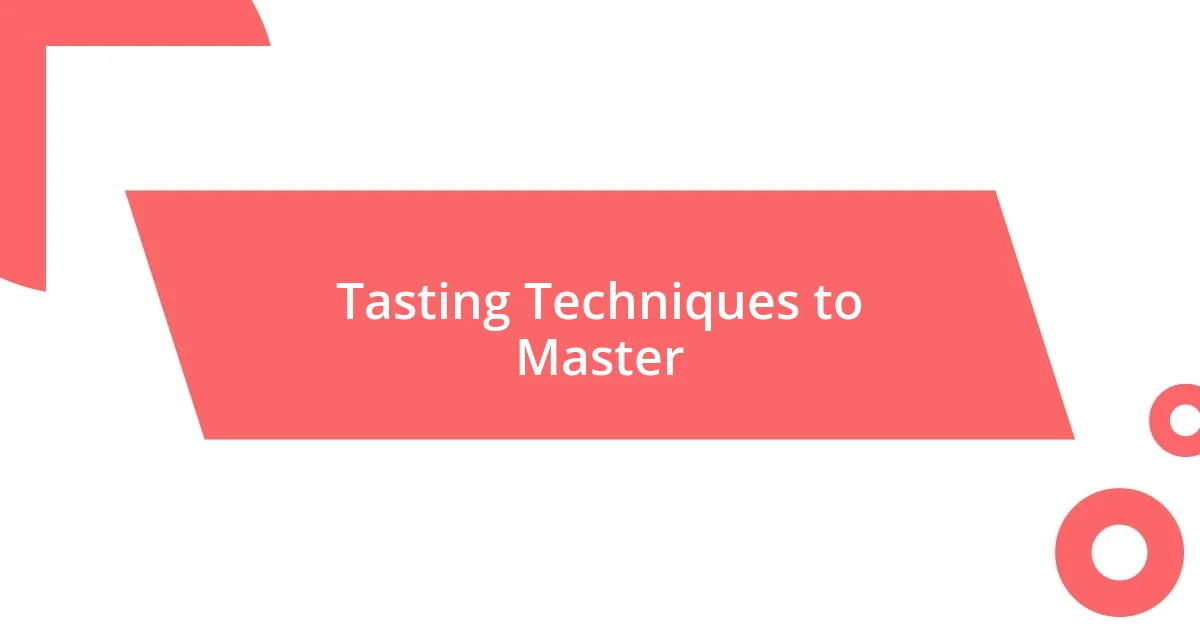
Tasting Techniques to Master
Mastering tasting techniques is fundamentally about engagement. I remember the first time I swirled a wine glass, watching the liquid cling to the sides, and I felt like I was unlocking a secret. Swirling isn’t merely for show; it aerates the wine, releasing the aromas that are just waiting to enchant you. I often find that taking a moment to admire the color can also reveal a lot — deeper hues might indicate richness, while lighter tones can suggest something more delicate. Have you ever taken a moment to appreciate what the color of a wine might hint at before diving into the tasting?
Another key technique is tasting in stages. The first sip is about the immediate flavors hitting your palate; the next is when you allow the wine to linger, revealing complex notes that might surprise you. I’ll never forget tasting a bold Shiraz where the initial blackberry burst transitioned into unexpected hints of pepper and chocolate. It was during that sip that I realized just how important it is to savor each stage; letting the wine unfold on your tongue not only heightens the experience but can also deepen your understanding of its character.
Lastly, don’t shy away from discussing what you’re tasting with fellow tasters. Sharing insights can open up an entirely new dimension of enjoyment and discovery. During a recent group tasting, I was genuinely astonished by how one person’s description of ‘leather’ made me re-evaluate what I was experiencing. This dialogue not only enriches the experience but also helps solidify the knowledge you gain. Have you tried sharing your thoughts while tasting? It can lead to unexpected friendships and a collective exploration of flavors that’s absolutely unforgettable.
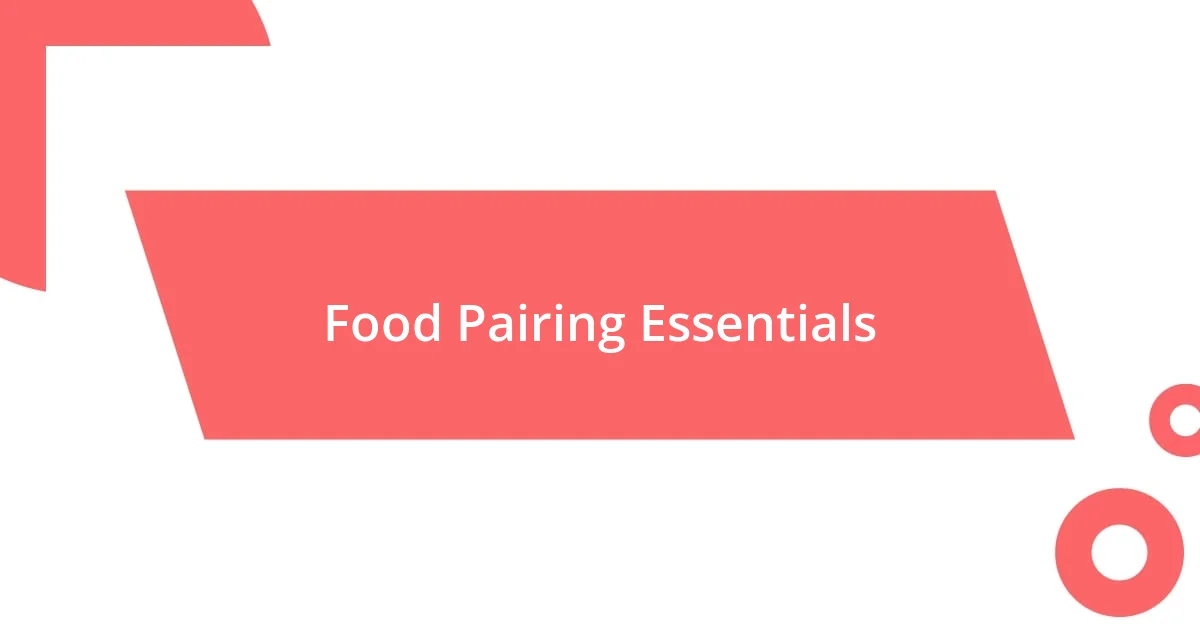
Food Pairing Essentials
Food pairing can transform a simple meal into an unforgettable experience. I’ll never forget my first encounter with a creamy brie paired with a crisp Chardonnay; the way the buttery texture of the cheese danced with the wine’s acidity was pure magic. Have you ever tasted something that made you stop in your tracks? That beautiful pairing heightened both components, showcasing the significance of understanding flavor profiles.
Drawing from my adventures in pairing, I’ve found that the key is balance. A rich, spicy dish may be complemented by a bold red, while lighter fare often benefits from the freshness of a white. I remember indulging in a hearty beef stew, and the full-bodied Cabernet Sauvignon I chose brought the flavors to life, creating a vivid tapestry of warmth and satisfaction. What’s your go-to pairing for comfort food?
Exploring regional pairings can also be revealing. I was taken aback during a wine tasting in Italy when a local Chianti harmonized perfectly with their rustic pasta dish. It reminded me that the influence of terroir — the environmental factors affecting a wine’s character — is essential. This notion connects both food and wine to their origins and cultures. Have you ever traveled and experienced such a connection? It can leave you with a deeper appreciation of not just the flavors but also the stories behind each pairing.
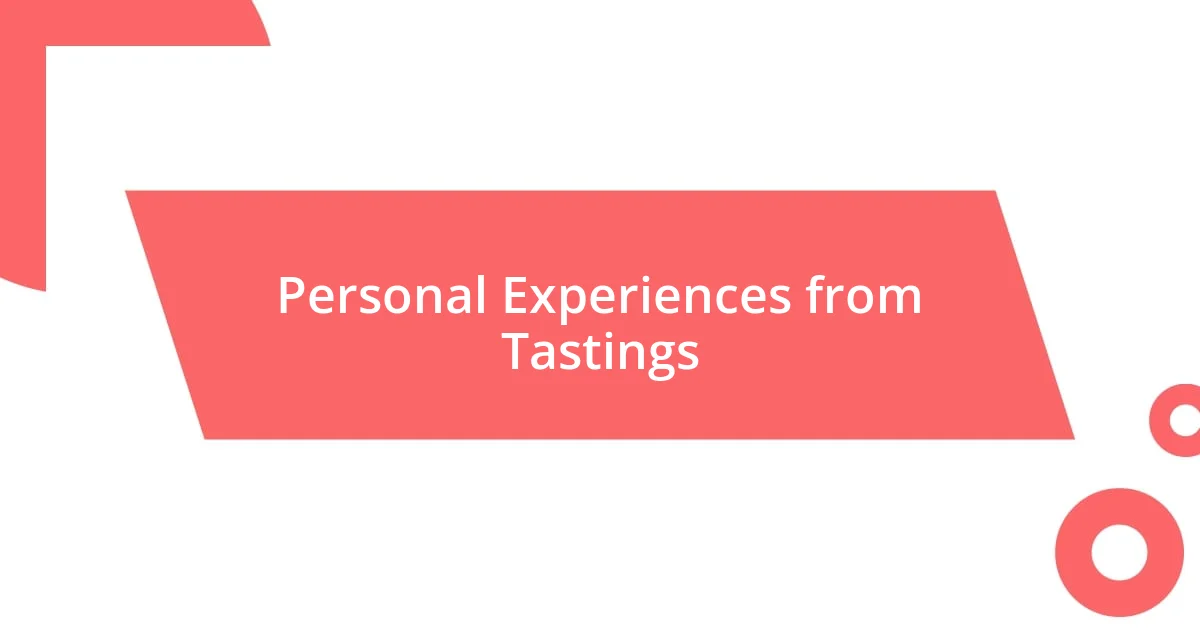
Personal Experiences from Tastings
I remember my first wine tasting at a quaint little vineyard tucked away in the countryside. As I savored a delicate Pinot Noir, the sun setting behind the rolling hills cast a magical glow. The experience was intoxicating—not just the wine, but the atmosphere, the people around me, and the way everyone shared their thoughts. Isn’t it fascinating how a single sip can transport you to a moment filled with such warmth and connection?
Another standout moment was during a tasting where a Merlot unexpectedly took center stage. I had always considered Merlot to be straightforward, but with each sip, I uncovered layers of black cherry and subtle herbal notes. It felt like peeling an onion—each layer revealing something new. Have you ever had a wine completely alter your perception? That evening, I learned the importance of being open-minded, as you might just stumble upon a hidden gem that changes your wine journey.
Lastly, I’ll never forget joining a blind tasting session, where the excitement grew with each pour. The challenge of guessing the grape variety sparked something exhilarating. I made a wild guess on a Zinfandel, and my confidence skyrocketed when it was revealed I was right! This experience taught me that engaging with the wine on a deeper level not only heightens pleasure but also builds my confidence and makes the exploration even more rewarding. Have you ever dared to participate in a blind tasting? It can truly elevate your wine appreciation game!
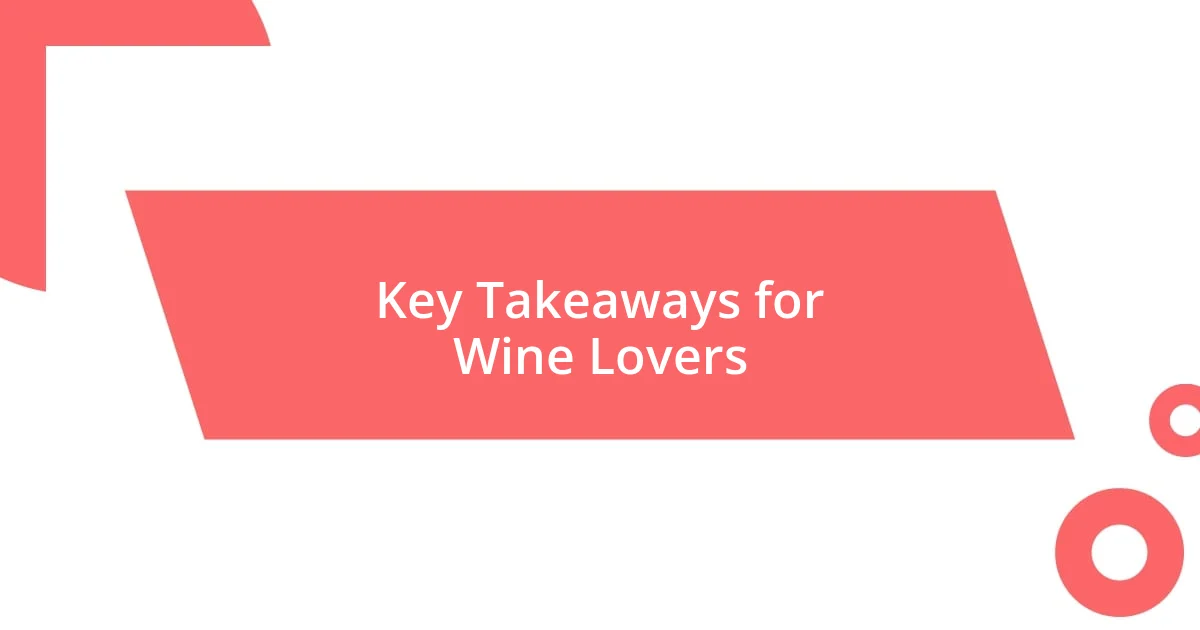
Key Takeaways for Wine Lovers
One key takeaway for any wine lover is to let each bottle tell its own story. I vividly recall a time when I opened a French Bordeaux with friends after a long week. As we poured and savored each sip, the discussion shifted to the region’s history, the vintner, and the unique climate conditions that shaped that particular vintage. Have you ever paused to think about the journey a wine takes before it reaches your glass? It adds layers of appreciation that make sipping so much more than just a moment of indulgence.
Another valuable lesson is the importance of personal exploration. I’ve been surprised by wines I initially dismissed, like a seemingly simple Sauvignon Blanc that I stumbled upon during a casual tasting. Its refreshing zest not only surprised me but also reignited my excitement for white wines. Have you ever challenged your preconceived notions about a particular varietal? Embracing this openness can lead to delightful discoveries and truly enrich your wine experiences.
Lastly, I believe sharing your wine journey magnifies the enjoyment. After hosting a small tasting at my home, where each friend brought a bottle they loved, I was amazed by the discussions and laughter that emerged. We shared stories associated with the wines, and it turned into a beautiful tapestry of our experiences, strengths, and preferences. Isn’t it incredible how a shared love for wine can form deeper connections? Making this a communal experience not only amplifies enjoyment but also cultivates friendships and lasting memories.



